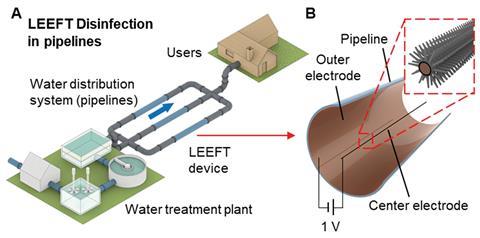Scientists in the US have developed a device that kills pathogens using an electric field. The tubular system can fit inside water distributions systems to deliver safe drinking water.
Drinking water typically goes through two disinfection phases. The first occurs at a treatment plant. The second combats pathogen regrowth and takes place in the pipe distribution system. Chlorination is a common part of this disinfection process. It is cheap, efficient and residual chlorine acts as a secondary treatment. It also has challenges to do with transport, storage and carcinogenic byproducts. Alternative disinfection techniques include membrane filtration, ozonation and UV. However, high costs, bromate byproducts and microbial regrowth in pipelines are the respective drawbacks of those alternatives. The ideal solution combines continuous disinfection with minimal maintenance, low power requirements and low costs.
Xing Xie and his team at the Georgia Institute of Technology have devised another disinfection system, which uses locally enhanced electric field treatment to kill pathogens. Central to the system are electrodes comprised of vertically aligned copper oxide nanowires coated with a protective polydomamine layer. Commercially available aluminium or copper tubing can serve as outer electrodes, making this tubular coaxial configuration scalable and compatible with current pipes.

The system creates a strong localised electric field around the nanowire tips – known as the lightening rod effect. Electrophoresis drives cells towards the centre of the device where irreversible electroporation kills them. Bulk water only encounters the background electric field. The system only consumes 1.4Jl–1 at an applied voltage of 1V, a power level that flowing water can generate in situ.
Sudipta Roy, head of the chemical and process engineering department at the University of Strathclyde, UK, calls it an ‘interesting and innovative design for water remediation using nanoscale electrochemistry.’
‘In a real-world scenario, segments of pipelines can be replaced with the locally enhanced electric field device every certain distance to provide consecutive antimicrobial power,’ comments Xie. He does concede that ‘pipeline replacement is a big project and cannot be done at once.’ Their first target would be existing pipelines that have exceeded their service life and are at risk of breaking.
Installing the technology on a large-scale would require the electrodes to be strong enough to endure high water flow and pressure. It’s also possible that debris in water may shield bacteria from inactivation at the electrode tips. Xie plans further investigations into these issues.
References
J Zhou et al, Environ. Sci.: Nano, 2020, DOI: 10.1039/c9en00875f












1 Reader's comment